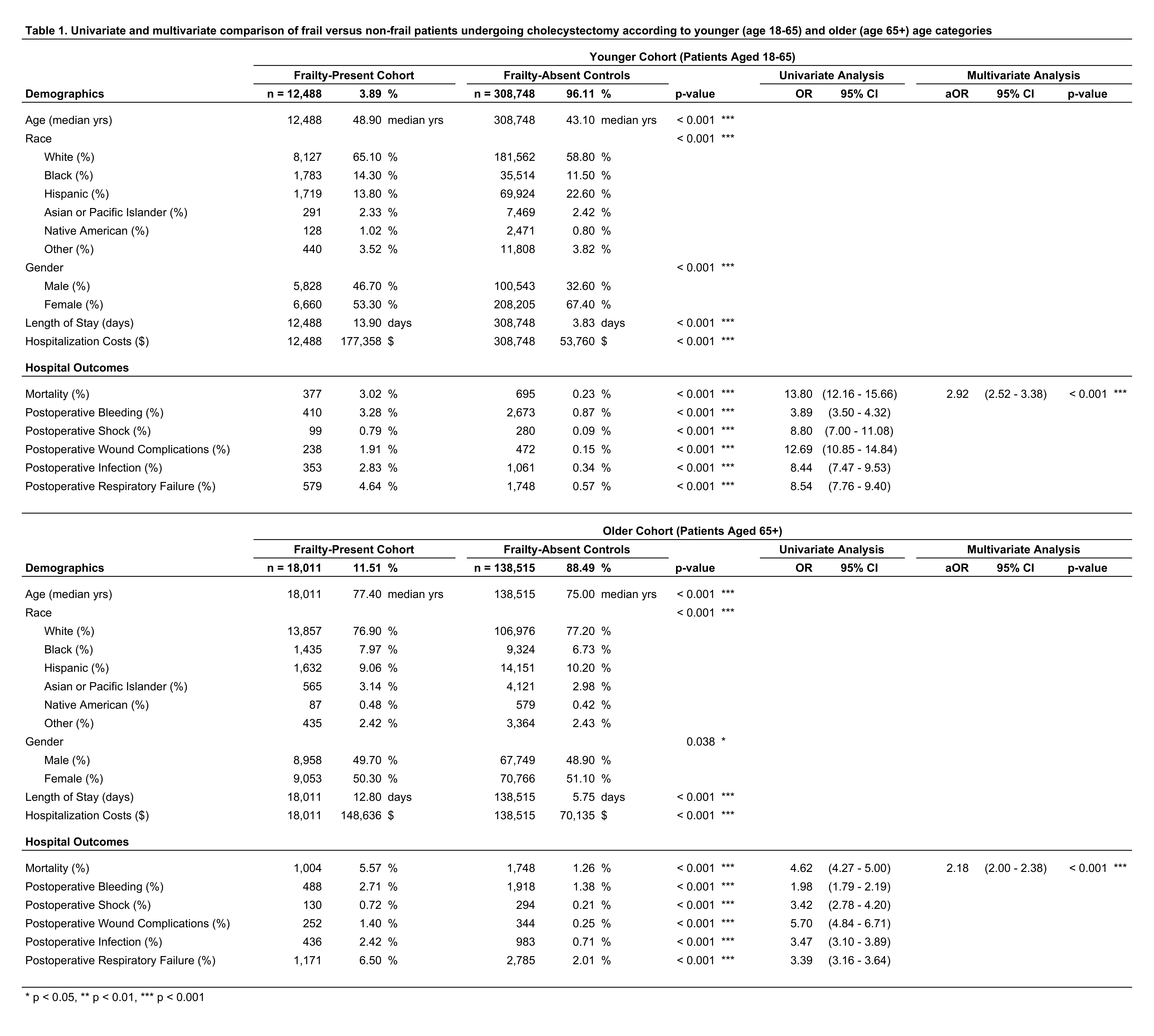THE CLINICAL IMPACT OF FRAILTY ON THE POSTOPERATIVE OUTCOMES OF PATIENTS UNDERGOING CHOLECYSTECTOMY: ANALYSIS OF 2011-2017 US HOSPITAL DATA
David U. Lee*, Gregory H. Fan, Raffi Karagozian
Tufts Medical Center, Boston, MA
Background & Aims: Recent literature has purported that the preoperative presence of frailty is linked to poor postoperative outcomes. In this study, we systematically evaluate the effect of frailty on postsurgical outcomes following cholecystectomy using a national registry of hospitalized patients.
Methods: The 2011-2017 National Inpatient Sample was used to identify inpatient cases of cholecystectomy (open and laparoscopic cholecystectomy), which were divided into younger category (18'‰¤age<65y) and older category (>=65y), and sub-stratified by frailty: a single composite variable defined by ACG Johns Hopkins frailty diagnostic indicators. The endpoints included mortality, length of stay, hospitalization costs, and postoperative complications. Those younger than 18 years or with gallbladder cancer were excluded.
Results: Of the cholecystectomy cases, 321236 were in the younger category and 156526 were in the older category. In younger category, there were 12488 with frailty and 308748 patients frailty. The frail cohort was younger (48.9 vs 43.1y p<0.01) and was more likely to be male (46.7 vs 32.6% p<0.01). Mortality was higher in the frail cohort (3.02 vs 0.23% p<0.01, OR 13.8 95%CI 12.2-15.7), as were LOS (13.9 vs 3.83d p<0.01) and hospitalization costs ($177,358 vs $53,760 p<0.01). In terms of complications, the frail cohort had higher rates of bleeding (3.28 vs 0.87% p<0.01, OR 3.89 95%CI 3.50-4.32), shock (0.79 vs 0.09% p<0.01, OR 8.80 95%CI 7.00-11.1), wound complications (1.91 vs 0.15% p<0.01, OR 12.7 95%CI 10.8-14.8), infections (2.83 vs 0.34% p<0.01, OR 8.44 95%CI 7.47-9.53), and respiratory failure (4.64 vs 0.57% p<0.01, OR 8.54 95%CI 7.76-9.40). In multivariate model, frailty was associated with increased mortality (aOR 2.92 95%CI 2.52-3.38). In older category, there were 18011 with frailty and 138515 without frailty. The frail cohort was older (77.4 vs 75.0y p<0.01) and was more likely to be male (49.7 vs 48.9% p=0.04). Mortality was higher in the frail cohort (5.57 vs 1.26% p<0.01, OR 4.62 95%CI 4.27-5.00), as were LOS (12.8 vs 5.75d p<0.01) and hospitalization costs ($148,636 vs $70,135 p<0.01). In terms of complications, the frail cohort had higher rates of bleeding complications (2.71 vs 1.38% p<0.01, OR 1.98 95%CI 1.79-2.19), shock (0.72 vs 0.21% p<0.01, OR 3.42 95%CI 2.78-4.20), wound complications (1.40 vs 0.25% p<0.01, OR 5.70 95%CI 4.84-6.71), infection (2.42 vs 0.71% p<0.01, OR 3.47 95%CI 3.10-3.89), and respiratory failure (6.50 vs 2.01% p<0.01, OR 3.39 95%CI 3.16-3.64). In multivariate model, frailty was associated with increased mortality (p<0.01, aOR 2.18 95%CI 2.00-2.38).
Conclusion: This study shows that frailty is a risk factor for poor mortality and postsurgical complications following cholecystectomy. Given this finding, frail patients should be identified early and provided a risk-benefit analysis prior to surgery.
This figure demonstrates the multivariate model evaluating the effect of frailty on postoperative mortality in younger (18-65) and older (65+) patients undergoing cholecystectomy
This table demonstrates the univariate and multivariate comparison of frail versus non-frail patients undergoing cholecystectomy in younger (18-65) and older (65+) categories
Back to 2021 Abstracts
